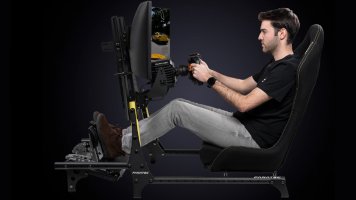Mr Latte
Premium
So waaay back around page 20 (approx a year ago) I started highlighting possibilities in using iPad as a means to control, multichannel audio-interfaces. This is commonly done by musicians in adding multiple inputs (instruments,mics,drums etc) to control them via specialist software apps or DAWs.
Not much feedback came from that and I kinda had hoped at the time some would, to help me better understand/determine the possibilities we could apply for control of tactile. I'm not a musician or magician but seen potential with this approach. Since that time, iPad has really, very much grown and established itself as a very serious and powerful tool for audio.
Finally, I have went with this approach to investigate such matters on recently buying an iPad pro 11" model. (what a great bit of hardware it is too)
Its a kinda Magic......
So I could do this on a PC for sometime but.........
What makes the iPad unique is how it can simplify things and with its awesome touch interface.
Within only minutes it was possible to connect the soundcard outputs to inputs on the interface, connect the interface via USB to a USB C hub and this connecting to the iPad.
Not Just Geek Factor
Possibilities arise in controlling audio channels and applying "plugins" to them as its a doddle but I am looking at different software options for this, more research to do. An example would be having an input, placing a Crossover Filter on it, Placing an EQ, then also a Spectrum Analyser. You name it. If its audio-based it can be applied. So much more plugins are available than we need as their are now hundreds of plugin tools. The KEY factor is how simple it is and how easy and seemlessly the iPad lets you swap between apps/tools. Some are free, some only a few quid and not like PC costing lots of money just for single plugins like this.
So for me, this is quite interesting indeed and I like what I am seeing as I never considered a PC DAW to be used to control my audio channels or tactile (previously only for monitoring) but this opens up new options with simple user interfaces and setup.
Simple Monitoring?
Here we have a "Gear Change" from SBS showing its frequency output via just one of the various audio apps I am looking at. Some of the options are quite amazing and cheap compared to VST plugins for PCs and typical DAWs.

 Monitoring in 5 minutes it works... I had two layers applied for "GearChange" set at 48Hz and 64Hz. Notice the peaks in this captured are quite accurate. We can exclude beyond 200Hz as we can apply a crossover to limit output of the tactile to this.
Monitoring in 5 minutes it works... I had two layers applied for "GearChange" set at 48Hz and 64Hz. Notice the peaks in this captured are quite accurate. We can exclude beyond 200Hz as we can apply a crossover to limit output of the tactile to this.
To do such consider that a cheap 2nd hand iPad could be used, software isn't that expensive, a USB hub/adapter is cheap and audio interfaces vary depending on number of channels they support.
A new door has been opened....
Not much feedback came from that and I kinda had hoped at the time some would, to help me better understand/determine the possibilities we could apply for control of tactile. I'm not a musician or magician but seen potential with this approach. Since that time, iPad has really, very much grown and established itself as a very serious and powerful tool for audio.
Finally, I have went with this approach to investigate such matters on recently buying an iPad pro 11" model. (what a great bit of hardware it is too)
Its a kinda Magic......
So I could do this on a PC for sometime but.........
What makes the iPad unique is how it can simplify things and with its awesome touch interface.
Within only minutes it was possible to connect the soundcard outputs to inputs on the interface, connect the interface via USB to a USB C hub and this connecting to the iPad.
Not Just Geek Factor
Possibilities arise in controlling audio channels and applying "plugins" to them as its a doddle but I am looking at different software options for this, more research to do. An example would be having an input, placing a Crossover Filter on it, Placing an EQ, then also a Spectrum Analyser. You name it. If its audio-based it can be applied. So much more plugins are available than we need as their are now hundreds of plugin tools. The KEY factor is how simple it is and how easy and seemlessly the iPad lets you swap between apps/tools. Some are free, some only a few quid and not like PC costing lots of money just for single plugins like this.
So for me, this is quite interesting indeed and I like what I am seeing as I never considered a PC DAW to be used to control my audio channels or tactile (previously only for monitoring) but this opens up new options with simple user interfaces and setup.
Simple Monitoring?
Here we have a "Gear Change" from SBS showing its frequency output via just one of the various audio apps I am looking at. Some of the options are quite amazing and cheap compared to VST plugins for PCs and typical DAWs.

To do such consider that a cheap 2nd hand iPad could be used, software isn't that expensive, a USB hub/adapter is cheap and audio interfaces vary depending on number of channels they support.
A new door has been opened....
Last edited:


















